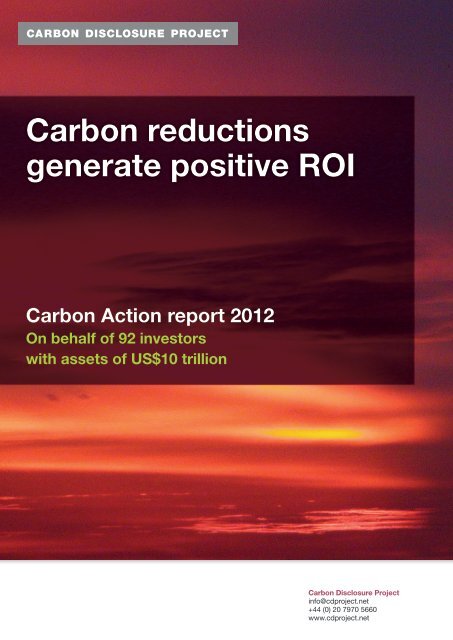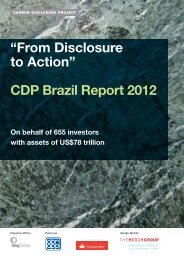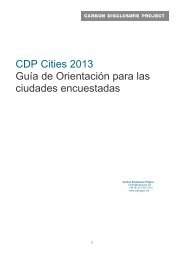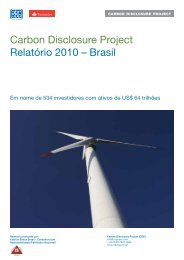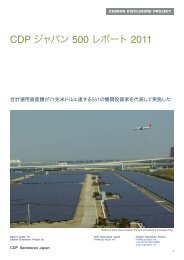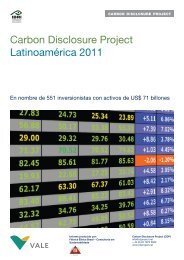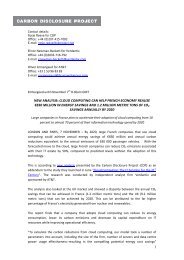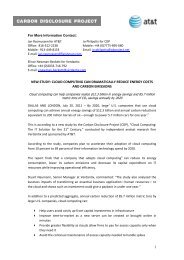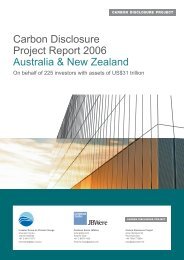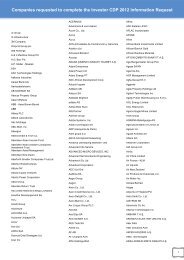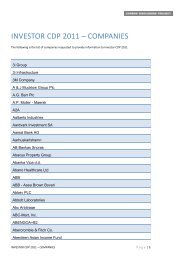Carbon reductions generate positive ROI - Carbon Disclosure Project
Carbon reductions generate positive ROI - Carbon Disclosure Project
Carbon reductions generate positive ROI - Carbon Disclosure Project
Create successful ePaper yourself
Turn your PDF publications into a flip-book with our unique Google optimized e-Paper software.
<strong>Carbon</strong> <strong>reductions</strong><br />
<strong>generate</strong> <strong>positive</strong> <strong>ROI</strong><br />
<strong>Carbon</strong> Action report 2012<br />
On behalf of 92 investors<br />
with assets of US$10 trillion<br />
1<br />
<strong>Carbon</strong> <strong>Disclosure</strong> <strong>Project</strong><br />
info@cdproject.net<br />
+44 (0) 20 7970 5660<br />
www.cdproject.net
2012 <strong>Carbon</strong> <strong>Disclosure</strong> <strong>Project</strong><br />
<strong>Carbon</strong> Action Signatories<br />
AEGON N.V.<br />
APG<br />
ATI Asset Management<br />
Australian Ethical Investment<br />
Aviva Investors<br />
Aviva plc<br />
AXA Investment Managers<br />
Banca Monte dei Paschi di Siena Group<br />
Banco Santander<br />
Banesto<br />
Banque Libano-Francaise<br />
Bâtirente<br />
BBVA<br />
Blumenthal Foundation<br />
Boston Common Asset Management,<br />
LLC<br />
BT Financial Group<br />
Calvert Investment Management, Inc<br />
Catholic Super<br />
CCLA Investment Management Ltd<br />
Ceres<br />
Clean Yield Asset Management<br />
ClearBridge Advisors<br />
Commonwealth Superannuation<br />
Corporation<br />
Connecticut Retirement Plans and Trust<br />
Funds<br />
Dalton Nicol Reid<br />
Development Bank of Japan Inc.<br />
DEXUS Property Group<br />
EEA Group Ltd<br />
Erste Asset Management<br />
Essex Investment Management<br />
Ethos Foundation<br />
F&C Investments<br />
FAPERS- Fundação Assistencial e<br />
Previdenciária da Extensão Rural do Rio<br />
Grande do Sul<br />
2<br />
CDP works with investors globally to advance the investment opportunities and reduce<br />
the risks posed by climate change by asking over 6,000 of the world’s largest companies<br />
to report on their climate change strategies, GHG emissions and energy use in the<br />
standardized Investor CDP format. Institutional investors including banks, pension funds,<br />
asset managers and insurance companies who sign the CDP questionnaire are known as<br />
CDP signatories.<br />
<strong>Carbon</strong> Action is an investor led initiative from the <strong>Carbon</strong> <strong>Disclosure</strong> <strong>Project</strong>. The aim is<br />
to ensure that portfolio companies undertake cost effective, value enhancing, carbon and<br />
energy efficiency measures to help improve strategic risk management for investors and<br />
companies. All CDP signatories can become <strong>Carbon</strong> Action Signatories to actively support<br />
this initiative and benefit from the exclusive CDP <strong>Carbon</strong> Action Engagement Handbook.<br />
For more information, please contact us or visit our website at www.cdproject.net.<br />
FASERN - Fundação COSERN de<br />
Previdência Complementar<br />
Fédéris Gestion d’Actifs<br />
First Affirmative Financial Network, LLC<br />
Generation Investment Management<br />
Global Forestry Capital SARL<br />
GPT Group<br />
Green Cay Asset Management<br />
Henderson Global Investors<br />
Hermes Fund Managers<br />
Holden & Partners<br />
Ilmarinen Mutual Pension Insurance<br />
Company<br />
Insight Investment Management (Global)<br />
Ltd<br />
Investec Asset Management<br />
Jupiter Asset Management<br />
Kaiser Ritter Partner Privatbank AG<br />
Keva<br />
KLP<br />
Legal & General Investment Management<br />
Lloyds Banking Group<br />
London Pensions Fund Authority<br />
Mercy Investment Services, Inc.<br />
Mergence Investment Managers<br />
Mn Services<br />
Mongeral Aegon<br />
MTAA Superannuation Fund<br />
Nathan Cummings Foundation, The<br />
Neuberger Berman<br />
Norfolk Pension Fund<br />
Oppenheim & Co. Limited<br />
Pax World Funds<br />
Pensioenfonds Vervoer<br />
Perpetual Investments<br />
PhiTrust Active Investors<br />
PKA<br />
Portfolio 21 Investments<br />
Q Capital Partners Co. Ltd<br />
Rabobank<br />
Rathbones / Rathbone Greenbank<br />
Investments<br />
Robeco<br />
Rockefeller Financial, Sustainability &<br />
Impact Investing Group<br />
SAM Group<br />
Sampension KP Livsforsikring A/S<br />
Sarasin & Cie AG<br />
Schroders<br />
Scottish Widows Investment Partnership<br />
Shinhan BNP Paribas Investment Trust<br />
Management Co., Ltd<br />
Signet Capital Management Ltd<br />
Sompo Japan Insurance Inc.<br />
Strathclyde Pension Fund<br />
Superfund Asset Management GmbH<br />
Swift Foundation<br />
TD Asset Management (TD Asset<br />
Management Inc. and TDAM USA Inc.)<br />
The Children’s Investment Fund<br />
Foundation<br />
The Joseph Rowntree Charitable Trust<br />
The Pension Plan For Employees of the<br />
Public Service Alliance of Canada<br />
The Sisters of St. Ann<br />
The Wellcome Trust<br />
Tri-State Coalition for Responsible<br />
Investment<br />
Union Investment Privatfonds GmbH<br />
VicSuper<br />
Walden Asset Management, a division of<br />
Boston Trust & Investment Management<br />
Company<br />
Westpac Banking Corporation<br />
Zevin Asset Management, LLC
CARBON ACTION 2012<br />
In this report, we offer investors key insights from the<br />
second CDP <strong>Carbon</strong> Action request and highlight<br />
how to use CDP data contained in the <strong>Carbon</strong> Action<br />
Engagement Handbook 2012 to improve analysis, support<br />
strategic risk management and facilitate shareholder<br />
engagement.<br />
We find that company investments in reduction projects<br />
are generating attractive returns well in excess of cost<br />
Key achievements:<br />
• <strong>Carbon</strong> Action has grown from 35 to 92 signatories<br />
representing $10 trillion in assets;<br />
• 61 companies have set new emissions reduction<br />
targets (from the original group of 205); and<br />
3<br />
WHAT IS CDP CARBON ACTION?<br />
1<br />
2<br />
3<br />
Letters sent to 256 companies in 17 high emitting industries, requesting:<br />
- emissions <strong>reductions</strong> (y-o-y); with<br />
- targets publicly disclosed; and<br />
- <strong>ROI</strong>-<strong>positive</strong> investments in projects.<br />
of capital, however, companies need to set more<br />
ambitious targets and reduce emissions to meet the<br />
IPCC target of 1.7% annual <strong>reductions</strong> in CO 2 e by 2020. 1<br />
We invite investors to sign on to <strong>Carbon</strong> Action 2013<br />
to engage companies on emissions <strong>reductions</strong> and to<br />
utilize the extensive company analysis presented in the<br />
<strong>Carbon</strong> Action Engagement Handbook 2012.<br />
• companies reported <strong>reductions</strong> of 497 million<br />
tonnes 2 of CO 2 e as a result of emission reduction<br />
activities totaling US$ 11 billion in 2012.<br />
Letters sent to 159 companies in 14 industries with potentially significant supply chain emissions, requesting:<br />
- demonstrate your actions with regard to managing the emissions in your supply chain<br />
Collaborative investor engagement coordinated by the Principles for Responsible Investment (PRI) using<br />
the <strong>Carbon</strong> Action Engagement Handbook 2012<br />
The development of CDP <strong>Carbon</strong> Action has been supported by Aviva Investors, Vestas and through advice from<br />
AXA Investment Managers, Catholic Super, CCLA, Hermes Fund Managers, Robeco and Scottish Widows Investment<br />
Partnership. It is backed by a growing group of leading investors including pension funds, asset managers, insurers and<br />
banks, who recognize the importance of climate / energy related strategic risk management and expect to see company<br />
activities resulting in cost-effective management and <strong>reductions</strong> of companies’ carbon emissions and energy usage.<br />
1 Progress in reducing emissions at the national level has not kept pace with the 2020 IPCC target (25-40% global CO2 e<br />
reduction) and, as of 2009, Annex 1 emissions were approximately 10% below 1990 levels. Therefore an annual reduction of<br />
1.7% for the remaining period to 2020 is required for Annex 1 countries to achieve the lower IPCC target of a 25% reduction by<br />
1990 levels, and 3.6% for the higher 40% target.<br />
2 Note: 497 million metric tonnes CO2 e represents the sum total of 860 emissions reduction activities reported in question 3.3b of<br />
the 2012 Investor CDP climate change questionnaire by 256 companies in heavy emitting industries. The 238 reported projects<br />
with complete financial information analyzed in this report total 110 million metric tonnes CO 2 e.
What’s new in year two<br />
The <strong>Carbon</strong> Action 2012 request was expanded to 415<br />
companies, twice the number of 2011 (205), targeting two<br />
discrete samples of global equities:<br />
1) 256 companies in 17 high emitting industries<br />
including Energy, Utilities, Materials, Industrials and<br />
Autos, up from 205 companies in 2011; and<br />
2) 159 companies in 14 industries with the potential<br />
for high supply chain emissions principally in the<br />
Consumer and Technology sectors.<br />
FIGURE 1: SUMMARY OF COMPANY ACTIVITIES<br />
4<br />
Our analysis of the data provided by companies that<br />
responded to the 2012 Investor CDP climate change<br />
questionnaire demonstrates the following:<br />
• carbon reduction activities are generating<br />
satisfactory <strong>positive</strong> return on investment with<br />
average IRRs of 33% delivering a payback in 3 years;<br />
• high emitting companies that set absolute emissions<br />
reduction targets achieved <strong>reductions</strong> double the<br />
rate of those without targets with 10% higher<br />
profitability; and<br />
• companies need to set more ambitious emissions<br />
reduction targets and follow through by investing<br />
in projects – nearly half of companies (36 of 87) that<br />
set targets did not report emissions <strong>reductions</strong> due to<br />
emissions reduction activities (ERA’s) in 2012.<br />
� Automobiles � Energy � Industrials � Materials � Utilities<br />
No. Companies<br />
100<br />
90<br />
80<br />
70<br />
60<br />
50<br />
40<br />
30<br />
20<br />
10<br />
0<br />
8<br />
21<br />
13<br />
30<br />
15<br />
Set a target Intensisty <strong>reductions</strong><br />
(y-o-y)<br />
4<br />
20<br />
13<br />
28<br />
13<br />
4<br />
14<br />
7<br />
17<br />
9<br />
Emmision <strong>reductions</strong><br />
due to ERA’s
FIGURE 2: COVERAGE UNIVERSE<br />
5<br />
CARBON ACTION GICS 4 SECTOR GICS INDUSTRY<br />
Industries with the<br />
highest emissions<br />
Industries with potentially<br />
high supply chain emissions<br />
Energy Oil, Gas & Consumable Fuels<br />
Utilities<br />
Materials<br />
Industrials<br />
Consumer Discretionary<br />
Consumer Staples<br />
Information Technology<br />
Electric Utilities<br />
Gas Utilities<br />
Independent Power Producers &<br />
Energy Traders<br />
Multi-Utilities<br />
Chemicals<br />
Construction Materials<br />
Metals & Mining<br />
Paper & Forest Products<br />
Air Freight & Logistics<br />
Airlines<br />
Building Products<br />
Commercial Services & Supplies<br />
Industrial Conglomerates<br />
Marine<br />
Road & Rail<br />
Automobiles<br />
Household Durables<br />
Internet & catalogue Retail<br />
Multiline Retail<br />
Specialty Retail<br />
Beverages<br />
Food & Staples Retailing<br />
Food Products<br />
Household Products<br />
Personal Products<br />
Communications Equipment<br />
Computers & Peripherals<br />
Electronic Equipment, Instruments<br />
& Components<br />
Office Electronics<br />
Semiconductors & Semiconductor<br />
Equipment
IRR %<br />
Energy efficiency delivers <strong>ROI</strong><br />
Our analysis of reported investments in energy efficiency<br />
and carbon reduction projects demonstrates that carbon<br />
reduction activities are generating <strong>positive</strong> return on<br />
investment (<strong>ROI</strong>).<br />
The average <strong>ROI</strong> is 33%, equivalent to a payback<br />
period of 3 years. With 63% of projects exceeding 30%<br />
<strong>ROI</strong> and 88% of projects exceeding firm level return on<br />
invested capital (<strong>ROI</strong>C) 3 , companies that have yet to<br />
invest in carbon <strong>reductions</strong> are missing high return<br />
opportunities to create financial value for their<br />
investors – irrespective of the environmental benefits.<br />
6<br />
We analyzed 860 emissions reduction activities<br />
reported by our sample of 256 companies in high emitting<br />
industries. Companies disclosed data on investment and<br />
annual savings in question 3.3b of the 2012 Investor CDP<br />
Climate change questionnaire in 2012. 4 Based on reported<br />
financial data to CDP, we calculated the average expected<br />
lifetime and the internal rate of return (IRR) for each of the<br />
emissions reduction activities specified in question 3.3b<br />
(see Fig. 3).<br />
We observed a broad range of projects spanning low<br />
hanging fruit such as behavioral change with high IRRs<br />
exceeding 100% with limited CO 2 e reduction, to low<br />
carbon energy installation with moderate IRRs at 12%<br />
but significant CO 2 e reduction.<br />
FIGURE 3: RETURN ON INVESTMENT FOR EMISSIONS REDUCTION ACTIVITIES<br />
>72<br />
60<br />
48<br />
36<br />
24<br />
12<br />
0<br />
• Product design<br />
• Transportation: use<br />
• Low carbon energy purchase<br />
Other •<br />
• Energy<br />
efficiency:<br />
Processes<br />
• Energy efficiency: building fabric<br />
• Energy efficiency: • Process emissions <strong>reductions</strong><br />
building services<br />
• Behavioral change<br />
•<br />
Fugitive emissions <strong>reductions</strong><br />
Transportation: fleet •<br />
•<br />
Low carbon energy installation<br />
0 20 40 60 80 100 120 140 >160<br />
Efficiency of emissions <strong>reductions</strong><br />
(kg CO 2 e / US$ mn)<br />
3 Return on Invested Capital (<strong>ROI</strong>C) = Net operating profit after tax divided by fixed assets + non-cash working capital<br />
4 Question 3.3b of the 2012 Investor CDP Climate Change questionnaire:<br />
For those initiatives implemented in the reporting year, please provide details in the table below:<br />
Emission Reduction Activity type, Description of activity, Estimated annual CO 2 e savings, Annual monetary savings (unit currency),<br />
Investment required (unit currency) or Payback period<br />
Source: <strong>Carbon</strong> <strong>Disclosure</strong> <strong>Project</strong>, Company data. Note: the figures in the exhibit above are based on 238 emissions reduction<br />
activities reported by sample of 256 companies in heavy emitting industries. Median IRR and efficiency of CO 2 e <strong>reductions</strong> are<br />
calculated based on figures reported to Investor CDP in 2012.
Targets are a clear first step<br />
57% of the 256 companies in high emitting industries set<br />
absolute and/or intensity targets for emissions <strong>reductions</strong><br />
in 2012. Companies with targets invested 1.1% of<br />
capital expenditure on emissions reduction activities<br />
– more than ten times that of companies without targets<br />
(0.08%) – and achieved year-over-year absolute<br />
<strong>reductions</strong> in CO 2 e of more than double the rate of<br />
companies without targets (see Fig. 4).<br />
Moreover, at the firm level, companies with published<br />
absolute emissions <strong>reductions</strong> targets were 10% more<br />
profitable (<strong>ROI</strong>C=10.2%) than those with intensity targets<br />
or no target at all (<strong>ROI</strong>C=9.3%) over the trailing twelve<br />
month period.<br />
7<br />
Companies disclosing targets for emissions <strong>reductions</strong><br />
<strong>generate</strong>d return on invested capital (<strong>ROI</strong>C) above industry<br />
median in 14 of 17 high emitting industries.<br />
We encourage investors to focus company<br />
engagement on setting targets as a first step towards<br />
both emissions <strong>reductions</strong> and return on investment<br />
above industry average.<br />
FIGURE 4: TARGETS, INVESTMENT, REDUCTIONS AND RETURN ON INVESTED CAPITAL<br />
� No Target � Target<br />
12%<br />
10%<br />
8%<br />
6%<br />
4%<br />
2%<br />
0<br />
CO 2 e investment<br />
as %capex<br />
1.1 1.6<br />
Absolute<br />
reduction<br />
Source: <strong>Carbon</strong> <strong>Disclosure</strong> <strong>Project</strong>, Bloomberg.<br />
3.3<br />
6.9<br />
8.8<br />
Intensity<br />
reduction<br />
9.3<br />
10.2<br />
Return on<br />
Invested Capital
Supply chain emissions also require<br />
management and <strong>reductions</strong><br />
In 2012, <strong>Carbon</strong> Action signatories identified 14 consumer<br />
and technology industries with the potential for significant<br />
risk exposure to carbon and energy usage in their supply<br />
chains to receive the 2012 <strong>Carbon</strong> Action letter. Investors<br />
asked the largest 159 Global 500 and FTSE All-World 800<br />
companies in these industries to manage emissions in their<br />
supply chains by working with suppliers to encourage<br />
action to deliver cost-effective emissions <strong>reductions</strong>.<br />
While 63% of companies report management of supply<br />
chain Scope 3 emissions and 58% report understanding<br />
long-term climate and energy risks and opportunities in<br />
8<br />
supply chains, we observe that only 32% measure and<br />
just 8% have set reduction targets for supply chain<br />
emissions (see Fig. 5) – mainly consumer companies in<br />
the food, beverage and retail industries (see Fig. 6).<br />
We recommend that investors focus engagement with<br />
companies in industries with potentially significant supply<br />
chain emissions on measurement and setting reduction<br />
targets for supply emissions. The <strong>Carbon</strong> Action Engagement<br />
Handbook 2012 contains industry-by-industry analysis<br />
to assess company management of supply chain<br />
emissions to facilitate investor engagement.<br />
FIGURE 5: FEW CONSUMER AND TECHNOLOGY COMPANIES ARE SETTING TARGETS TO REDUCE<br />
SUPPLY CHAIN EMISSIONS<br />
70<br />
60<br />
50<br />
40<br />
30<br />
20<br />
10<br />
0<br />
Management of supply<br />
chain emissions<br />
Awareness of supply chain<br />
risks and opportunities<br />
Measurement of supply<br />
chain emissions<br />
Reduction target for<br />
supply chain emissions<br />
FIGURE 6: % OF RESPONDING COMPANIES WITH REDUCTIONS FOR SUPPLY CHAIN EMISSIONS<br />
Food Products<br />
Beverages<br />
Speciality Retail<br />
Food & Staples Retailing<br />
Electronic Equipment, instruments<br />
Communications Equipment<br />
Computers & Peripherals<br />
Office Electronics<br />
Semiconductors & semiconductor<br />
Household Products<br />
Personal Products<br />
Household Durables<br />
Internet and Catalogue Retail<br />
Multiline Retail<br />
Source: <strong>Carbon</strong> <strong>Disclosure</strong> <strong>Project</strong>, Company data.<br />
0 5% 10% 15% 20%
How to use the <strong>Carbon</strong> Action<br />
Engagement Handbook 2012<br />
CDP produced the <strong>Carbon</strong> Action<br />
Engagement Handbook 2012 for signatories<br />
to CDP <strong>Carbon</strong> Action to facilitate company<br />
engagement (in coordination with the UN<br />
Principles for Responsible Investment).<br />
The handbook includes detailed, company<br />
specific analysis on a range of carbon<br />
reduction and energy efficiency activities,<br />
including high emitting industries and those<br />
with potential for high supply chain emissions.<br />
Sign on to <strong>Carbon</strong> Action 2013<br />
We invite investors to sign up in 2013 to<br />
accelerate cost effective company action on<br />
energy efficiency and carbon reduction.<br />
Signatories will benefit from:<br />
• corporate climate / energy<br />
management data<br />
• analysis<br />
• engagement facilitation<br />
9<br />
A traffic light table providing detailed company<br />
level information is color-coded to highlight<br />
leaders and laggards by industry and is also<br />
available in Excel to support further analysis.<br />
<strong>Carbon</strong> Action is designed to advance<br />
understanding of portfolio company carbon<br />
management and energy efficiency initiatives<br />
and to improve risk management in areas<br />
including regulation, operations, fiduciary duty<br />
and reputation.
Notes<br />
10
CDP <strong>Carbon</strong> Action has been generously supported by:<br />
CDP would like to acknowledge the following <strong>Carbon</strong> Action catalyst group members<br />
for their input to this report:<br />
Matt Christensen<br />
AXA Investment Managers<br />
Emma Herd<br />
Westpac<br />
Helen Wildsmith<br />
CCLA<br />
11<br />
Thomas Deser<br />
Union Investment<br />
Craig Mackenzie<br />
SWIP<br />
Freddie Woolfe<br />
Hermes Fund Managers<br />
Design and production<br />
Danielle Essink-<br />
Zuiderwijk<br />
Robeco<br />
Stephanie Maier<br />
Aviva Investors<br />
Danyelle Guyatt<br />
Catholic Super<br />
Olivia Watson<br />
UNPRI<br />
Production Studios is a Creative, Design and Production Company based in London.<br />
We specialise in the creation of Communication, Marketing and Advertising materials<br />
for clients in the retail, leisure, travel, corporate, not-for-profit and charity sectors.<br />
For more information on Production Studios visit: www.productionstudios.co.uk<br />
Or email: carl@productionstudios.co.uk
CDP Contacts<br />
Emanuele Fanelli<br />
Senior Vice President, Investor<br />
Initiatives<br />
+ 44 (0) 20 7415 7030<br />
Emanuele.Fanelli@cdproject.net<br />
Marc Fox<br />
Director, Investor Initiatives<br />
- North America<br />
+1 212 378 2088<br />
Marc.Fox@cdproject.net<br />
Michelle O’Keefe<br />
Director, Technical Reporting<br />
+44 (0) 20 7415 7048<br />
Michelle.O’Keeffe@cdproject.net<br />
Important Notice<br />
12<br />
Esben Madsen<br />
Technical Officer<br />
+44 (0)20 7970 5685<br />
Esben.Madsen@cdproject.net<br />
Kora Cora Krause<br />
Senior Relationship Manager<br />
+49 (0) 30 311 777161<br />
kora.cora.krause@cdproject.net<br />
Marcus Norton<br />
Head of Investor Initiatives and Water<br />
Frances Way<br />
Co-Chief Operating Officer –<br />
Programs<br />
<strong>Carbon</strong> <strong>Disclosure</strong> <strong>Project</strong><br />
40 Bowling Green Lane<br />
London, EC1R 0NE<br />
United Kingdom<br />
Tel: + 44 (0) 20 7970 5660<br />
Fax: + 44 (0) 20 7691 7316<br />
www.cdproject.net<br />
info@cdproject.net<br />
The contents of this report may be used by anyone providing acknowledgement is given to <strong>Carbon</strong> <strong>Disclosure</strong> <strong>Project</strong> (CDP). This does not represent<br />
a license to repackage or resell any of the data reported to CDP or the contributing authors and presented in this report. If you intend to repackage or<br />
resell any of the contents of this report, you need to obtain express permission from CDP before doing so.<br />
CDP has prepared the data and analysis in this report based on responses to the CDP 2012 information request. No representation or warranty<br />
(express or implied) is given by CDP or any of its contributors as to the accuracy or completeness of the information and opinions contained in this<br />
report. You should not act upon the information contained in this publication without obtaining specific professional advice. To the extent permitted<br />
by law, CDP and its contributors do not accept or assume any liability, responsibility or duty of care for any consequences of you or anyone else<br />
acting, or refraining to act, in reliance on the information contained in this report or for any decision based on it. All information and views expressed<br />
herein by CDP and any of its contributors is based on their judgment at the time of this report and are subject to change without notice due to<br />
economic, political, industry and firm-specific factors. Guest commentaries where included in this report reflect the views of their respective authors;<br />
their inclusion is not an endorsement of them.<br />
CDP and its contributors, their affiliated member firms or companies, or their respective shareholders, members, partners, principals, directors,<br />
officers and/or employees, may have a position in the securities of the companies discussed herein. The securities of the companies mentioned in<br />
this document may not be eligible for sale in some states or countries, nor suitable for all types of investors; their value and the income they produce<br />
may fluctuate and/or be adversely affected by exchange rates.<br />
‘<strong>Carbon</strong> <strong>Disclosure</strong> <strong>Project</strong>’ and ‘CDP’ refers to <strong>Carbon</strong> <strong>Disclosure</strong> <strong>Project</strong>, a United Kingdom company limited by guarantee, registered as a United<br />
Kingdom charity number 1122330.<br />
© 2012 <strong>Carbon</strong> <strong>Disclosure</strong> <strong>Project</strong>. All rights reserved.


